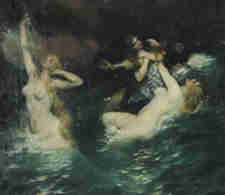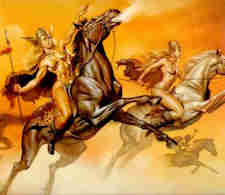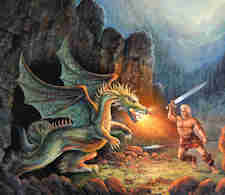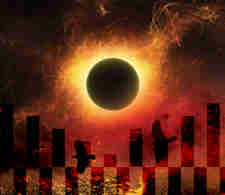Der Ring des Nibelungen
Ideas-free patchwork staging signals Bayreuth’s fading authority
Valentin Schwarz’s new staging of Wagner’s epic has some thought-provoking moments, but few were sustainable and most were just distracting
In the final pages of his Ring cycle, Wagner’s orchestral writing reaches extraordinary heights of grandeur and conviction, in music that depicts the destruction of an old corrupt world and the dawn of a new untainted one. It is the moment to which everything in the cycle has been leading, the moment when the tangled and dishonest world of the gods, in which the audience has been enmeshed across four operas and nearly 16 hours of music and drama, comes crashing down. It is by any standards climactic.
As these final pages were reached in Valentin Schwarz’s new Ring cycle at the Bayreuth festival, the conductor Cornelius Meister and the festival orchestra, in the concealed Bayreuth pit, were playing out of their skins as the score demanded. Above them on the stage, however, Iréne Theorin’s Brünnhilde, who is supposed to be the agent of destruction and rebirth, was settling herself on the bottom of an empty and dirty swimming pool next to the dead body of her husband Siegfried, the remains of her mutilated horse in a plastic bag, and with no suggestion at all in Schwarz’s staging that a moment of artistic significance had been reached.
It had not helped that Theorin had just delivered an undistinguished account of the final scene of Götterdämmerung, one of the cycle’s great vocal set pieces. But if the climax of this Ring contained any suggestion that a new order of things had somehow been made possible, it was hard to see where it was. The music, in short, was saying everything, but the staging, an empty pool full of junk, nothing. As the curtain fell, it triggered a fusillade of booing – along with cheering too.
Audiences journey from around the world to Bayreuth to watch the Ring Cycle whenever it is staged; Wagner’s purpose-built theatre still has tremendous allure and mystique. Occasionally, everything comes together, as it did last in Barry Kosky’s 2017 Die Meistersinger, conducted by Philippe Jordan, and before that in Stefan Herheim’s brilliant Parsifal in 2008, conducted by Daniele Gatti. But the days when Bayreuth could claim to set the world’s standards in Wagner production – as it did in the late 19th century when the festival began, and then again after the second world war, when the composer’s grandson Wieland Wagner and successors Patrice Chéreau and Harry Kupfer reconceived the works afresh, have gone.
Schwarz’s cycle was a further milestone in Bayreuth’s continuing loss of authority and direction. You might even say, in true Wagnerian manner, that this was a cursed Ring Cycle. Originally scheduled for 2020, it arrived two years late due to the pandemic with a new conductor, Meister, drafted in at short notice after Pietari Inkinen contracted Covid. Meister’s direction was fluent and competent without coming close to the excellence of Christian Thielemann’s conducting of Lohengrin in the middle of the Ring week. Important castings were changed right up to the first performances, with Tomasz Konieczny injuring himself when a chair broke during Die Walküre, requiring Michael Kupfer-Radetzky to make a successful substitution at very short notice, and Clay Hilley stepping in for Stephen Gould as Siegfried in Götterdämmerung at the last minute.
The music, was saying everything; the staging, an empty pool full of junk, was saying nothing
The cycle nevertheless produced good moments. Schwarz’s idea, in Rheingold, that the cycle’s foundational sin was the seizure of a child, not of the gold from which a ring of power would be created, was challenging in the best sense. In Die Walküre, successfully subverting another big moment to the horror of traditionalists, he placed the final focus of the opera on Fricka’s futile triumph over Wotan, not on Wotan’s farewell to his daughter Brünnhilde. In Siegfried, the unwrapping of the tightly bandaged Brünnhilde was a striking take on Siegfried’s moment of female discovery. In some ways the most successful staging of the cycle was act two of Götterdämmerung, performed without fuss or distraction inside a simple white cube set that felt like a 20th-century throwback.
The quality of singing was episodic too. The only truly standout performance was Lise Davidsen’s Sieglinde, a performance for the ages. Klaus Florian Vogt, in his element as Lohengrin under Thielemann, brought his otherworldly tone to Siegmund too, outstanding in the annunciation of death scene with Brünnhilde, but less effective in conveying the character’s tortured loneliness. Most of the various Wotans (there were three) were adequate rather than notable. The two Brünnhildes (Daniela Köhler took the role in Siegfried, with Theorin in the other two operas) were as commanding as the role requires. Andreas Schager was a wonderfully manic Siegfried, ringingly dauntless throughout his name opera. Olafur Sigurdarson was a fine and plausible Alberich. Georg Zeppenfeld an exemplary Hunding.
Too often, though, the cycle was a patchwork, coming briefly into focus and then slipping out of it again. Illuminating ideas were not followed through and in truth were not often sustainable. It tried to do too much, some of it interesting and thought-provoking, too much of it merely distracting and inconsequential. It added extraneous characters and details (such as unscripted children of various characters), while ignoring many of Wagner’s intentions (there was no ring, no spear, no dragon, an intermittent sword and a halfhearted attempt at a Tarnhelm). The Schwarz cycle ran out of steam in the end because it had no big or unifying idea – not even a really bad unifying idea such as Frank Castorf’s pretentious 2013-17 Bayreuth Ring which preceded this one.
New Ring cycles are springing up as the world’s opera houses get back into their rhythms after the pandemic. It is a competitive market. Among others, there was a well received one in Leipzig in June, a promising one in Zürich, there’s another in Berlin this autumn and two in London in the years to come. Bayreuth remains an extraordinary venue, its ambitious ability to mount a new cycle in a single season is remarkable, and the 150th anniversary Ring, to be mounted there in 2026, will doubtless be a global event. But the festival feels as though it needs a radical rethink if it is to merit the reputation and attention.
Martin Kettle | 8 Aug 2022
A New ‘Ring’ at Bayreuth Does Wagner Without Magic
Valentin Schwarz’s production of the four-opera epic presents human characters with relations even more tangled than usual.
About 150 years ago, in a megalomaniac’s coup, Richard Wagner built a theater on a hilltop here in northern Bavaria.
His immense, complex, innovative operas had never been presented as he imagined them. If he wanted them done right, he concluded, he would have to do them himself.
But when the Bayreuth Festival Theater opened in 1876, with the premiere of his full “Ring of the Nibelung” — a four-opera, 15-hour mythic tale about nature and power with a cast of gods, warriors, dwarves, giants, talking birds and spitting dragons — Wagner was still unsatisfied.
Among the most intractable (and inadvertently laugh-inducing) problems were the magical effects he called for: girls frolicking in the depths of a river; transformations into serpents; Valkyries riding through the air on horseback. Even now, with 21st-century stage technology, what Wagner makes musically persuasive has struggled to be visually and dramatically so.
In his intriguing, insightful new production of the “Ring” at the Bayreuth Festival, the young director Valentin Schwarz has dealt with those problems by sidestepping them entirely.
Schwarz’s acidic, passionately performed, contemporary-dress version is a “Ring” without magic or nature, in which all the characters are human, their relations even more tangled than usual, and all the events take place on a single estate.
While in the libretto, the dwarf Alberich briefly turns himself into a lowly toad, that is here just a metaphor; it’s mentioned in the text, but nothing happens. The mighty Valkyries don’t fly through the sky, but bray around a waiting room in spike heels, flame-colored nouveau riche outfits and cosmetic surgery bandages. Siegfried, the flawed hero, is given a sword — or at least a shard that resembles one — but it does nothing supernatural. (The weapons here are mostly handguns.)
This is all of a piece with the demythologizing trend in Wagner stagings over the past 50 years, especially in Europe. The most influential ones over that period have been made in the shadow of George Bernard Shaw’s interpretation of the “Ring” as an allegory of anticapitalism, with the action set more or less in the present and the gods depicted as members of the modern upper classes, the characters’ nobility and valor as mostly sham.
That was also the case with the last Bayreuth “Ring,” by Frank Castorf, which ran from 2013 to 2017. But compared with Castorf’s gleefully baffling staging, which often abandoned coherent storytelling altogether, Schwarz’s is fairly straightforward in its account of the codependence and acrimony running through a family. There are whiffs of daytime soaps in the harsh vividness of the visuals and acting, and a bit of “Succession,” too.
If the “Ring” is an allegory — a reach for some conservative operagoers, but a given for many directors — the conceptual anchor of a production is the nature of the gold, the theft of which from the Rhine, in the opening minutes, is the sin that sets the epic plot in motion.
The gold — and the powerful, toxic ring it’s molded into — symbolizes the commodity that the onstage world values most. For Castorf, it was oil, corroding political and social relations as it circulated through the globalized economy. For Schwarz, picking up on the magic apples the libretto says the gods require to retain their freshness, it is youth, innocence, children.
His “Ring” is full of adults obsessed with appearing younger — through exercise, plastic surgery, absurd attempts at hip clothing — even as, more than in most stagings, they visibly age over the cycle.
This obsession tips over into ominous hints of child trafficking and abuse; the slaves of Nibelheim are here a roomful of identically dressed blonde girls drawing at tables. (The girls aren’t overtly hurt, but they’re clearly being hoarded.) The dwarf Mime’s workshop is a creepy tea party and puppet theater for raggedy homemade dolls. And in Schwarz’s most original and inspired idea, the gold is not a bit of metal, but an actual young boy whose abduction embodies a society curdled by its attempts to outrun death.
The life cycle is the focus from the beginning. The libretto sets the start of the “Ring” beneath the flowing waters of the Rhine, but Schwarz instead shows us an animated projection of a womb, in which twin fetuses are frozen in a gesture somewhere between love and combat.
That image of a family’s foundational claustrophobia is a key to all that follows, as the action plays out in and around the gods’ home, Valhalla. (The forbiddingly sleek, spare sets are by Andrea Cozzi, the evocatively changing light by Reinhard Traub, and the fiercely trashy costumes by Andy Besuch.) The giants who, in the libretto, have been conned into constructing the lair are here chic architects of a glassy expansion. Alberich now isn’t of a different race than Wotan, the king of the gods, but is his less successful brother.
The all-knowing Erda and the brutal Hunding are part of the estate’s omnipresent, watchful servant underclass, which shines the silver as the main characters suffer. Later, Mime and the dissipated Gibichungs, Gutrune and Gunther, are ever more depraved inhabitants of parts of the property, long after the gods have passed on.
The role of Wotan, his hands ever pawing at women at their most vulnerable, is shared by the sturdy Egils Silins (in “Das Rheingold”) and the brooding Tomasz Konieczny (“Die Walküre” and “Siegfried”). In the second act of “Walküre” last week, Konieczny had an appropriately bourgeois accident — the back of his Eames lounge chair broke off, and he tumbled to the floor — so he sat out the third act, giving Michael Kupfer-Radecky the opportunity to jump in, superbly, a few nights before his manic turn as Gunther.
In “Siegfried,” the title character was sung by the tirelessly secure Andreas Schager, subtly unfolding the lovable side of a drunken degenerate. In “Götterdämmerung,” Clay Hilley was a last-minute replacement as Siegfried, and he would have been impressive even under less dramatic circumstances.
“Die Walküre” was notable for Klaus Florian Vogt’s pure, rapt Siegmund and Lise Davidsen’s tender, surging Sieglinde, by far the most vocally resplendent performance of the week. Daniela Köhler sang brightly in the short but daunting Brünnhilde part in “Siegfried”; in the much longer “Walküre” and “Götterdämmerung,” Iréne Theorin acted with intense commitment to the staging, but her sizable voice wobbled under pressure.
Stepping into the production just a few weeks ago to replace a sick colleague, the conductor Cornelius Meister led a solid, sensibly paced, somewhat faceless reading of the sprawling score.
For all that is clear, even blatant, about Schwarz’s staging, there is much that is memorably, lyrically ambiguous. Appearing periodically throughout his “Ring” is a small, glowing white pyramid in a glass cube. Characters occasionally carry it, and it sometimes sits next to furniture or in the corner, but it’s never explained or dwelled on. It is whatever you think it is: a model of the pyramidal addition to Valhalla; a stylized sword or spear tip; purity; energy; antiquity; aspirations before and beyond the complications of reality. It is, in essence, a line of poetry, enigmatic and evocative.
Similarly, drawings of stereotypically Wagnerian faces with winged helmets keep popping up — they’re what the girls are making in Nibelheim — before taking form as the red masks carried by the sinister crowd of vassals in “Götterdämmerung.” Do they represent the stultifying weight of tradition in presenting the “Ring”? The dark side of German nationalism?
Thankfully, it’s not specified — nor is the meaning of the omnipresent horse figurines and toys. The most important horse in the cycle, Brünnhilde’s Grane, is, like the gold, here a real person: a tall, dependable, silent aide with an equine mane and beard.
There were indelible images throughout the week: the giant Fafner (Wilhelm Schwinghammer) moldering at home on his deathbed; Alberich (Olafur Sigurdarson) and Hagen (Albert Dohmen) confronting each other on a palely lit stage, empty but for a punching bag that Hagen attacks, then forlornly embraces; Hagen’s slow, mournful dance as he leaves, waving Alberich’s leather jacket like a bullfighter.
And at the end of “Die Walküre,” we don’t see Brünnhilde asleep in a ring of fire, but rather the final attempt of Fricka (Christa Mayer) to reconcile with Wotan, her husband. He walks away, leaving a single candle burning as the curtain closes, a nod toward the libretto’s fire that captures the emotions of the music and the moment in a fresh light.
But while the abandonment of enchantment is often illuminating, occasionally it ties Schwarz in knots. Since there is no potion to cause Siegfried to forget — and cruelly betray — his love for Brünnhilde, their ecstatic duet earlier in “Götterdämmerung” needs to be staged, unconvincingly, as a fight to give motivation for his bitterness. And both Theorin and the staging run a bit out of steam in the closing, apocalyptic Immolation Scene, with Brünnhilde wandering aimlessly, then cradling Grane’s decapitated head as she lies down next to the murdered Siegfried at the bottom of the estate’s drained, dirty pool.
Instead, the real coup of “Götterdämmerung” is the realization, earlier on, that the kidnapped Rheingold-boy has grown up to become the embittered, ambivalent Hagen. Painfully, in Schwarz’s staging, we see him treat Brünnhilde and Siegfried’s young child (an addition to the libretto) as callously as he was — the wheel of fear and abuse continuing to turn.
And the production’s final image is a reprise of its first: again, twin fetuses, but this time in seemingly peaceful embrace. Is that peace lasting? Or will birth inevitably bring about a renewal of resentment, betrayal and violence? With admirable restraint, Schwarz doesn’t define whether he thinks a sick world is capable of change.
Zachary Woolfe | 7 Aug 2022
A production by Valentin Schwarz (premiere)
Cornelius Meister replaces Pietari Inkinen
Also available as audio broadcast










